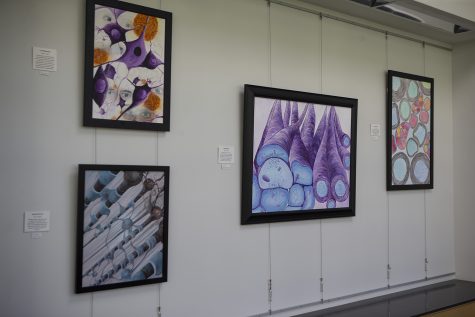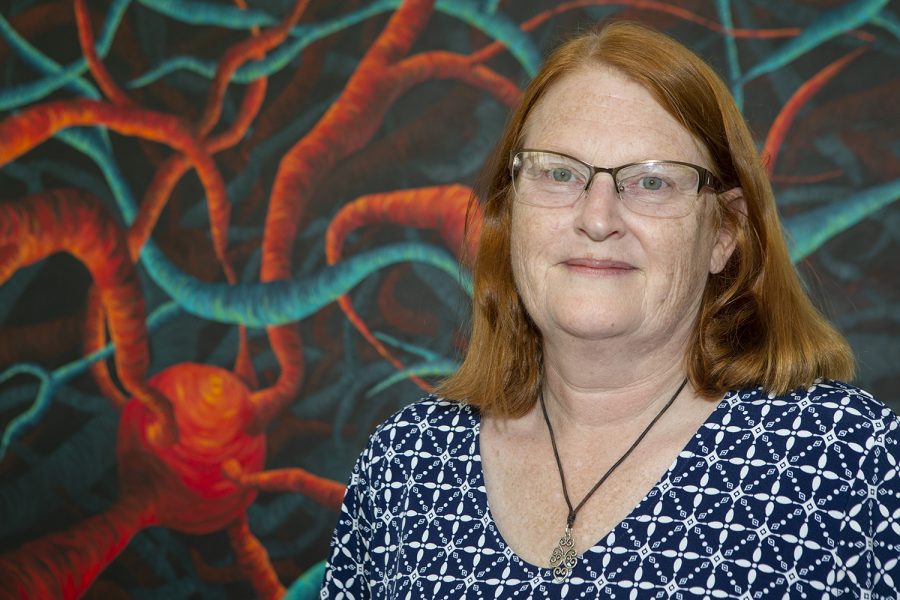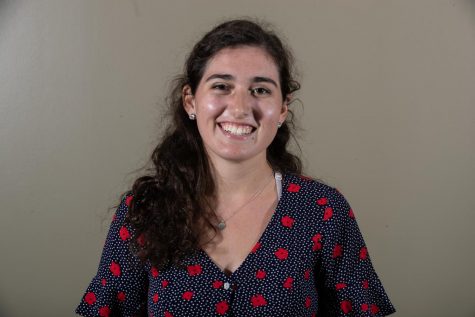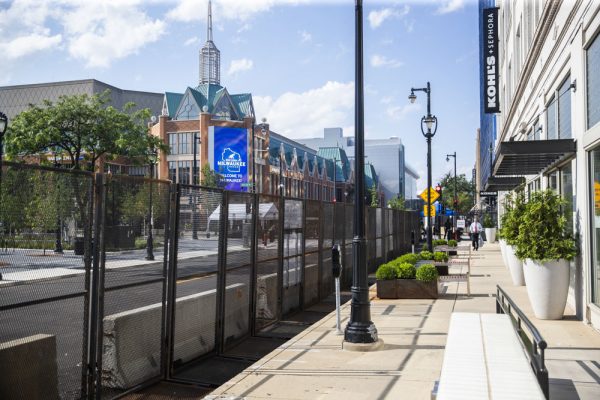UI professor brings art and science together in new exhibit
Professor Kathleen Sluka researches pain at the UI. Her work as a scientist inspires her work as an artist, in which she creates large and colorful paintings of cells.
Professor of Physical Therapy Kathleen Sluka poses in front of her artwork in the Pappajohn Biomedical Discovery Building on July 29, 2019. Her artwork focuses on the life of cells. (Katie Goodale/The Daily Iowan)
July 29, 2019
University of Iowa Professor Kathleen Sluka takes depictions of cells beyond what would be found in a biology textbook, creating grand colorful paintings of the cells she studies in her day job.
Sluka studies the cells of the body for a living. Sluka runs a research lab studying pain mechanisms.
Her exhibit, Cells of Life, is on display in the sky gallery of the Pappajohn Biomedical Discovery Building and Medical Education & Research Facility through Oct. 9.
“My art depicts the cells of the body in normal and diseased conditions. It’s meant to bring the beauty of the human body to the public,” she said. “My main goal is to bring the science into something people can see — bring colors in, bring beauty in, bring some structure and some thoughts out there for everybody to look at. It’s really about the beauty of the body at a microscopic level.”
Sluka said she was interested in art in high school but did not start seriously creating art again until around 10 years ago.
“I kind of put [art] away while I built my research career, raised my family, all that great stuff,” she said. “I came back and started about 10 years or so ago, and a few years ago, I painted some neurons, and I thought: Oh yeah, this is what I should be doing. It took me awhile to figure out what I should really be doing, because that’s what I know, and I’ve seen most of these images one way or another before. I have a good idea of what the structures are and what they look like.”

Professor of Physical Therapy Kathleen Sluka’s artwork is seen in the Pappajohn Biomedical Discovery Building on July 29, 2019. Her artwork focuses on the life of cells. (Katie Goodale/The Daily Iowan)
Sluka’s art has previously been displayed in UI Hospital & Clinics gallery spaces, as well as at the Society for Neuroscience in San Diego. Her work has also appeared on the cover of scientific journals.
Mary Kenyon, a communications specialist for the Pappajohn Biomedical Institute, finds art to place in the sky gallery, located in the skywalk between two medical buildings.
Kenyon says the gallery, which has been used for around four years, is designed to showcase the work of Iowa artists.
While Kenyon had worked with Sluka for several years, she discovered Sluka’s work as an artist after her exhibition at a Society for Neuroscience conference.
“If she’s exhibiting here for all these neuroscientists, we should have her at home as well so that everybody here would be able to see this other dimension of this person they know as a scientist,” Kenyon said.
Kenyon said displaying art in the sky gallery is conducive to the work of researchers in the facilities.
“The creative process that goes into making the art is similar and can be informative to the process of the science that they’re doing. People think of science as following directions, but they really are very creative in coming up with new ideas and new solutions to old problems,” she said.
Rebecca Taugher, a postdoctoral researcher in psychiatry at the Iowa Neuroscience Institute, said that she enjoyed the focus on science in Sluka’s exhibit.
“It’s always really exciting when they change the art display — thought it was particularly exciting to see science being incorporated into the art,” Taugher said. “You can tell it’s art from a scientist because it’s correct anatomically. There really is a lot of beauty in neuroscience.”
















